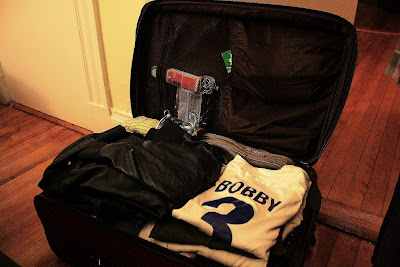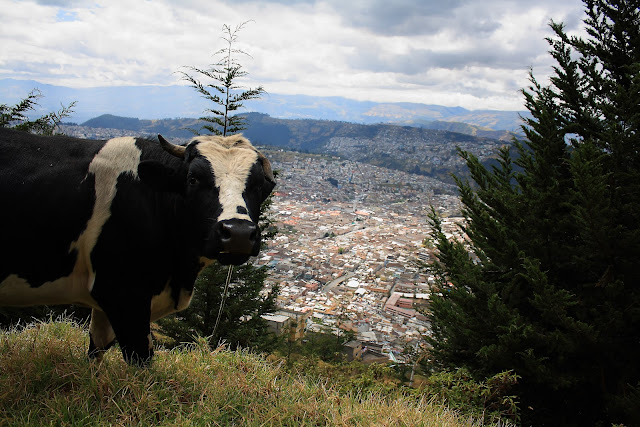Boston, MA. 6:00 AM, Tuesday August 14th, 2012. All my bags were packed, I was ready to go I'm standing here outside your door. The day I was waiting for had finally come.
 |
Obligatory (and stereotypical) shot of my luggage.
|
|
|
|
|
|
|
|
|
I was catching a flight from Logan Airport to Miami in about three hours, where I would join up with the rest of the people studying abroad this semester (of which I had only met one so far) and catch a group flight to Quito.
 |
| 3,055 miles. And my first time in the southern hemisphere - I hear everything is upside down over there. |
I am well known for being a huge procrastinator, which is the reason I finished packing all of my stuff around 4am the night before. I didn't have time to make coffee, so I was running on sheer excitement and the frozen yogurt I had at Mixx with Hernando, Tina, and Stephanie (roommate, roommate, and tele-roommate, respectively) the night before.
 |
| I needed to fill my quota for the semester, I don't think I will find very much frozen yogurt anywhere in Ecuador. | |
|
|
All three of them decided to accompany me to the airport that morning. Steph showed up at our door like at 6:15, at which time we all hopped into Tina's new car (whose name is Nöelle).
 |
| Hernando and I agree -Stephanie sucks at taking pictures. I had to run it through like 3 filters so it would look decent. |
|
We weren't going straight to the airport however - Oh no...we were taking a delicious pit-stop at The Breakfast Club, a breakfast joint in upper Allston. I am the biggest breakfast person you will ever meet (sometimes I go to sleep excited because I know I'll be having breakfast the morning after). I couldn't leave the US without having one last fix. And yes, this place is named after the eponymous 80s movie -which just adds the the awesomeness.
 |
| Seriously, look at this menu. Guess which one I had. |
|
 |
| OMNOMNOMNOMNOM |
After that huge plate of Basket Case goodness (of which no food items were spared), it was airport time - but not before Hernando, Tina, and Stephanie decided to surprise me with some farewell gifts. Stephanie (who has a weird fetish for japanese/korean stationary products) gave me a sweet notebook to write in while I was abroad - she had judged me for buying 75¢ composition books at Target the other day, and couldn't let me leave without having something "decent" to write in. However, I think my favorite thing was the custom coloring book she made for me, complete with Charles Darwin, Incas, llamas, and blue-footed boobies.
 |
| Actually, Blue-footed "Bobby" |
Hernando and Tina (ok, mostly Tina - but Nando helped...maybe) made me a sweet farewell "card" - and I say "card" because it was actually a bag from REI converted into a great collage with pictures from our previous year together. At this very moment, it hangs in my Ecua-room.
 |
| Best roommates ever. |
After a few more "awww" moments of roommate bonding, we got to the airport and said our last goodbyes. I was off. Getting through airport security was easy enough - I even met another person in the program while all my crap was going through the X-ray machines. I met even more once I got to the gate. We talked for a bit (mostly about how big our bags were and something about British game shows), but pretty soon it was time to board the plane. My strategy to not sleep the night before payed off, as I slept pretty much the whole way to Miami.
 |
| My phone was not in airplane mode when I took this. #WhatABaddass |
|
|
|
|
Back in Boston, I had made the mistake of not making sure my checked bag was transferred to the connecting flight in Miami - and it was basically because I had been too lazy to find and give the flight information to the airline lady. So when I got to Miami, I had to exit security, pick up my bag at the claim, check it at the LAN counter (which was on the other side of the goddamn airport), and go through security again (but I'm going to Ecuador so who cares...first world problems right?). I finally made it to the international gate, and here I met pretty much everyone else on the program. Seemed like a solid group.
Again, I slept through a large portion of the flight to Quito (I can sleep anywhere if I set my mind to it - it's a handy skill/superpower to have). I woke up again a little bit before landing - and by that time, it had already gotten dark. When we made it over land and got close to Quito, I was absolutely blown away. Seeing all of the huge mountains and the deep valleys of the Andes all covered in lights was one of the craziest sights I had ever seen.
 |
| I took this picture but it does not do justice to how amazing it was in any way whatsoever. |
 |
| Flying into Quito for the first time. (taken from: http://thetimeistudiedabroadinecuador.tumblr.com/) |
|
|
|
|
|
|
|
|
I was already pumped, but that sight multiplied my excitement by about x9001. I could already tell this was going to be a magical place. Once we landed, I made it through customs pretty easily (well, let's be honest...as easily as getting through customs can get - that crap always sucks no matter how you spin it). My host mother Irene was waiting for me outside the airport entrance. We had emailed before, but I had no idea what she looked like or even how old she was. Thankfully, she was holding up a sign with my name on it. We walked outside together, and I was surprised with how great the temperature was - cool, but not cold...although the flannel I was wearing helped). Her husband Adolfo was waiting for us in a boxy little blue Volvo from the early 90s.
On the way to my new home, they talked to me about Quito a little bit, asked me questions about what I was studying, and where I was from. They were also surprised (and a little relieved, I think) that I spoke Spanish. They came off as a very cute and old-fashioned couple - just think of a pair of adorable grandparents. She is a stay-at-home wife, and is like one of those grandmas who constantly spoils you and gives you more food than you could possibly eat so you're not too "flaquito". Adolfo makes furniture for a living, and loves classical music. In fact, the first thing he did when we got to the house was show me the basement (that sounds weird, I know, but I'm not done). This is like his lair, where he keeps some of the furniture he's made (which is stunningly beautiful by the way - so much old world craftsmanship, it's the kind of furniture you would expect to find in the bedroom of some duke in a royal palace in England - and that's not hyperbole) and sits down to listen to classical music every night while he reads the bible (they are also very religious).
They told me I shouldn't eat anything heavy for dinner, because my body needed to acclimatize to the altitude and eating something big right away would almost certainly end badly - so they just gave me some bread and cheese (no complaints, those are two awesome foods right there). Oh, and they also gave me some mate de coca (yes, the same coca as cocaine, which is probably why it's illegal in the US), a great tasting tea that has been used for generations as a remedy for altitude sickness - and pretty much every other ailment - by Andean natives. (In case you were wondering, no, I did not get high).
Afterwards, I went into my new room, did the usual moving-in chores, and jumped into bed. It had been a long day, but 3,500 miles later, I could tell an adventure was brewing - of which I will be writing about very soon.
But for now, I'll just leave you with these pictures of my new 'hood:
 |
| The entrance to my new home. So welcoming. |
 |
| I live in the white house. Part of Pichincha, the volcano, can be seen in the background. Fun fact: Pichincha is to the west, and you can use it to orient yourself from anywhere, because Pichincha is visible from anywhere in Quito. |
 |
| The other side of the street, leading up to 10 de Agosto, one of the main avenues in Quito. 10 de Agosto is known as the date of the "Primer Grito de Independencia", the day that sparked the revolution and independence from Spain. A lot of streets in Quito are named after important dates. |






























































